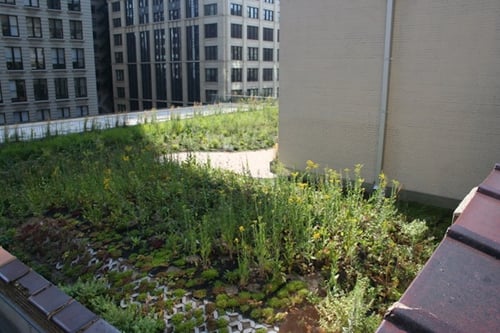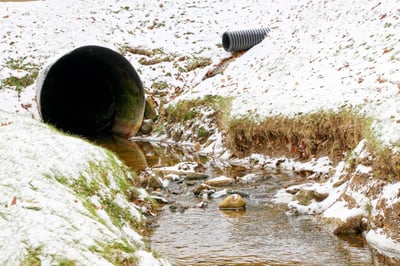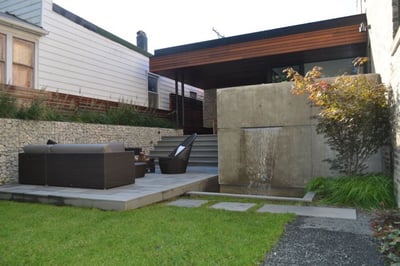Green stormwater infrastructure is a growing need in our world, as cities bloom and rural areas feel their effects. Are you missing out on its benefits?
When we say huge, we don’t just mean “large” or “sizeable” or any other half-measure word that politicians use.
We mean huge.
It’s a problem to which we must start paying attention, but we have to do it in the right ways … and that means going green.
How Big a Problem Is Stormwater?
 Consider how much stormwater Chicago has to handle every year (and we sincerely hope you had your coffee, because we’re about to do some math):
Consider how much stormwater Chicago has to handle every year (and we sincerely hope you had your coffee, because we’re about to do some math):
The city of Chicago gets 38 inches of rain and 35 inches of snow per year, on average. That totals 73 inches of precipitation. The average amount of water produced by one inch of rain falling on one acre is 27,154 gallons.
As there are 640 acres to a square mile and Chicago is 234 square miles, it is 149,760 acres in area, getting more than 4 million gallons per citywide inch in any rain or snow event. Multiply that out by the 73 inches of precipitation the city gets every year, and that’s almost 300 billion gallons annually.
(For comparison, that’s more than 7.6 million hot baths. Because we all like numbers in terms we can understand.)
Don’t believe our math? Check out this rainfall calculator by inputting 234 square miles and 75 inches. It checks out. And every one of those gallons strips impermeable surfaces of pollution and disease, carrying them into waterways and wild habitats.
Obviously we need to do something about this issue, but in many cases, we’re taking the wrong approach.
A Quick Recap: Green Versus Gray Stormwater Infrastructure
 So, green stormwater infrastructure, huh? Is this just another gimmicky distinction, another claim by the environmentalists that we’re getting it all wrong?
So, green stormwater infrastructure, huh? Is this just another gimmicky distinction, another claim by the environmentalists that we’re getting it all wrong?
Well, no. Green infrastructure has much more to offer than gray in several ways. We’ve already covered the major differences between green and gray stormwater infrastructure here, so if you missed it and want a deep dive, go ahead and take a look. For now, let’s recap quickly.
In a nutshell, the concern with gray infrastructure – think giant dykes made of cement, metal culverts, concrete roadside ditches – is that they don’t do anything with the water other than try to funnel it somewhere else. There are two main problems with this:
- The water hasn’t been treated until it arrives at its destination, either a wastewater treatment plant (which itself relies on environmentally damaging chemicals) or straight into the watershed.
- Gray infrastructure often cannot handle the sheer amount of stormwater that falls on large cities. When its capacity to manage rainfall and snowmelt gets overrun, we see environmentally destructive events such as combined sewer overflows (CSOs).
- Gray infrastructure is itself an impermeable surface, meaning it collects pollution, toxins and disease agents, which then get washed into public and wild waterways.
Gray infrastructure, quite simply, isn’t cutting it. We need something better.
The Benefits of Green Stormwater Management

Green stormwater infrastructure is, as you might have guessed, heavily plant-based … but not exclusively.
For instance, rain collection barrels are one type of stormwater solution that takes in surplus water during rain events, ready for use during dry periods.
Permeable pavers are another solution. These raised paving stones have holes or cracks in them to allow water through. That way it soaks into soil and vegetation rather than sheeting over the ground and into nearby sewers or waterways.
Then there are the natural systems: green roofs, rooftop gardens, rain gardens, bioswales, ponds. These are all examples of created habitats that suck up rainwater, retaining and detaining it until later. (Translation: holding onto it or slowing it down, respectively.)
The main benefits of green stormwater structures include:
- Built-in filtration: Because green systems rely on plants, soil and soil-like medias, they have filtration systems already baked in on installation. They capture that stormwater that would run over the surface of gray infrastructure and pull it in, where it filters through soil and roots before evaporating into the environment or trickling into the watershed. When it emerges after filtering, it is much freer or disease and pollution.
- Resilience: Plants are much better at responding to changes in the environment than gray infrastructure. They can go dormant, grow during beneficial periods and spread. Gray infrastructure is what it is, so it can’t respond to change.
- Sustainability: By using good stewardship principles, we can keep green infrastructure going much longer than gray. Instead of having to tear down and rebuild, using chemicals and raw materials, we can partner with green systems to keep them healthy over the long term. They take care of themselves much more effectively and require far fewer inputs.
- Public health: If you’ve ever looked at a giant dyke (you know, the type they’re always driving through in The Fast and the Furious) and thought to yourself, “Man, that looks great for me!” then you are alone. Gray infrastructure has no health benefits whatsoever, whereas green provides fresh air, cooling effects, reduced pollution and more.
Pretty neat, right?
Where Do You Start with Stormwater Management?
If you’re wondering how to get started with green stormwater solutions, we’re here for you.
Ecogardens takes great pride in helping companies and private residents to develop sustainable, resilient, plant-based stormwater systems that will help manage today’s precipitation and tomorrow’s changing climate.
Plus, we’ll totally geek out about math, like, any time you want.
Want to learn more about doing your part, saving money and making a better world? All you have to do is get in touch today.


